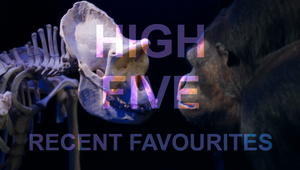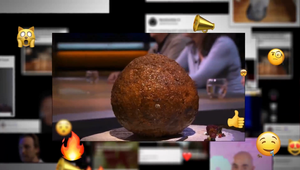
How a Meatball Made of Mammoth Meat Kicked off a New Food Revolution

Above: the Mammoth Meatball after its reveal, credit Aico Lind
Last month, the world’s first meatball made from woolly mammoth DNA - dubbed the ‘Mammoth Meatball’ - was revealed at the Nemo Science Museum in the Netherlands. A scientific experiment and creative collaboration between Wunderman Thompson Benelux, Australian cultured meat start-up Vow, Wefilm and a group of international experts, it demonstrated the potential of cultured meat to revolutionise the food industry.
But, the Mammoth Meatball is not just a cutting-edge innovation or an eye-grabbing headline - it is a striking statement aiming to challenge the public and the meat industry to think in a different way about how we produce and consume food. It all feeds into Vow’s mission to feed billions of people every day with the help of cultured meat products. “To do this, we need to make better meat for meat lovers and vegans alike,” says co-founder and director of the company Tim Noakesmith. “While there are currently over 100 cultured meat companies around the world, Vow’s approach really sets us apart. We believe that replicating existing products is not enough to change behaviour on a massive scale. It is not enough for cultured meat products to taste as good as chicken or beef. We aim for our products to taste and be better. By focusing on innovation over replication, we’re creating truly cutting-edge dining experiences.”
Using innovative molecular technology, cultured meat is genuine animal meat, grown from the cells of animals instead of the animals themselves. It can be designed to be preferable in both taste and nutritional value, while simultaneously lowering the harm done to the environment and causing no harm to any animal. In a bid to highlight the potential of cultured meats and challenge the food industry, the idea of the Mammoth Meatball experiment was born. Bas Korsten, global chief creative officer at Wunderman Thompson and the initiator of the idea, says that by galvanising scientists and creatives, this project has the potential to change the future.
So, how come is it made of mammoth meat? James Ryall, Vow’s chief scientific officer, explains that bringing the extinct protein back to life started by identifying the mammoth gene - mammoth myoglobin - which is what gives meat its typical taste. Then, using publicly available data, the scientists at Vow identified the DNA sequence in mammoths while filling in any gaps by using the genome of the African elephant - the closest living relative of the mammoth. Using a very low count and high voltage charge, the team then inserted the mammoth myoglobin gene into new cells, subsequently growing and multiplying them. “The amazing thing is, not one single animal had to be hurt to produce the mammoth meatball,” says James.
In fact, the idea of making cultured meat from the DNA of an extinct animal had been one that the wider team at Wunderman Thompson Benelux had been discussing for some time, with various iterations developing overtime before they landed on the final idea of using the woolly mammoth. The team were interested in Vow as a collaborator, which gave start to the conversations prior to the campaign, Wunderman Thompson wanting to feel out the scope for collaboration and further development of the idea. Soon enough, both teams were en route to maybe the most important meatball ever made.
As an agency, Wunderman Thompson also had to invest a lot of research time to wrap their heads around the new concept of cell-based meat and its potential impact on the food industry. It then worked closely with Vow to understand its technology and how it could be used to create a meatball that would showcase the potential of its products, while remaining true to the creative vision and messaging.
While cultured meat is currently available in Singapore for consumers to buy, and is expected to be served in the US and Australia soon, very few know what it actually is. Putting the story out into the worldwith such an eye-catching name was important for both Vow, as an up-and-comer in the sector, and Wunderman Thompson, as the bearers of the idea.
“We knew we had to do something outrageous,” says co-founder Tim. “Our main goal behind producing the Mammoth Meatball was to start the conversation with future consumers about where their food comes from today, and the impact of that food system on our climate. It’s a bold and exciting experiment that challenges us to think outside the box and imagine a future where meat consumption can be so different from what we know today.”
For Tim, the scope in usage of cultured meat is virtually limitless. It’s also particularly important to acknowledge that it’s ‘not just for vegans’, he says. “We’re inventing products that meat lovers and vegans alike choose selfishly because they are tastier, more nutritious and more sustainable. This is what will allow us to really have a positive impact on the future of our planet.”
In terms of messaging, Jasper Korpershoek, senior creative at WT Benelux, explains the importance of positioning cell-based meat as a feasible cooking option, not just the best ethical choice. “Additionally, we recognised that audiences may feel intimidated by the concept of cultured meat, therefore we focused on its potential as a tasty and environmentally conscious choice. By presenting the Mammoth Meatball as an alternative that is both sustainable and ethical, we believe it has more potential to appeal to a wider audience and become a more mainstream option in the future.”
The teams at Vow and Wunderman Thompson then got to work with Wefilm and director Juliette Stevens to create a short documentary about the project. “The documentary showcased the process behind the creation of the meatball and highlighted the potential that cultured meats have. We are using various channels, including social media and led by an extensive global PR campaign, to ensure that people all over the world saw the Mammoth Meatball,” adds Jasper.
While Vow has no plans to continue making mammoth products, nothing is totally off the cards when it comes to cell-based meat, says Tim. Its next cultured meat product is expected to launch in Singapore - cultured Japanese quail - this year, and it will be fully available to the public. “We believe that the future of the food industry lies in sustainable and ethical alternatives like cultured meat, so we expect to see more developments in this area, as consumers become more aware of the environmental and animal welfare concerns associated with traditional meat production,” adds Jasper.t. “We also anticipate more creative collaborations between scientists, agencies like Wunderman Thompson and technology firms, to promote these alternatives to a wide audience using creative solutions.”
However, nothing is as easy as it sounds. The biggest challenges facing cell-based meat today and in the future - and the reason why it isn’t tearing through the US and European markets - are the numerous scientific setbacks and the necessity to pivot the approach to development accordingly. This is what also delayed the launch of the meatball and what stood in the way of the teams actually tasting it. “However, we persevered and never gave up on our goal of creating more awareness surrounding the future of food,” says Jasper. “We are not yet allowed to taste the Mammoth Meatball due to laws and regulations surrounding cell-based meat production. Before an extinct protein can be brought to market, extensive testing must be conducted to ensure that this ancient product is safe for human consumption,” he says.
Making the Mammoth Meatball edible was never the goal - it was to push the limits of new technology to its very edge and create something that has never been done before, to showcase the innovative science involved in cultured meat. Jasper adds, “During the cooking process, however, we observed that it emitted a scent similar to that of crocodile meat, which is quite intriguing. While we cannot comment on the taste this time, we are excited to continue exploring this innovative and sustainable food source.”
Ultimately, the mammoth meatball serves as a reminder that we are at the beginning of a food revolution like we have never seen before. For the sake of better living, a better planet and a better us. “Vow is excited to be part of this movement towards a more sustainable food future, creating more cutting edge products with cultured meat. We believe that we are just at the start of a conversation about what meat could be, and are excited to create brighter possibilities for ourselves and the planet,” vouches Tim.
Jasper adds, “The Mammoth Meatball campaign demonstrated how the integration of creativity and science can drive meaningful change in any industry. By highlighting the potential of cultured meat, we are promoting sustainable and ethical alternatives that have the power to transform the very nature of food. I look forward to continuing to support and promote the development of creative ideas within the field of science and technology.”













